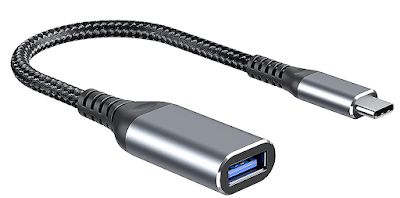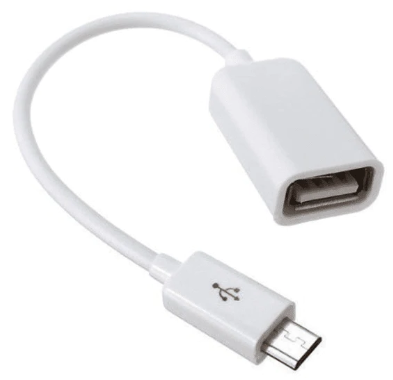OTG Cable Full Form | OTG Cable | Type C OTG Cable | C Type OTG Cable | OTG Cable Type C | Micro USB Cable | Type C to Micro USB Cable
Are you tired of transferring files from your phone to your computer and vice versa? Do you want a quick and easy way to connect your phone to a USB device? Look no further than the OTG cable or Micro USB cable or Type C OTG cable. In this article, we'll discuss what the OTG cable full form means, its uses, and how to use it effectively. An OTG (On-The-Go) cable is a type of cable that allows devices to communicate with each other directly, without the need for a computer or any other intermediary device. It is typically used to connect two mobile devices, such as smartphones or tablets, together so that they can share data or other types of information.
How Does an OTG Cable Work?
An OTG cable works by allowing one device to act as a host and the other as a peripheral device. For example, if you connect a smartphone to a tablet using an OTG cable, the smartphone would act as the host and the tablet would act as the peripheral device. This means that the smartphone would be in charge of controlling the connection and accessing the files on the tablet.
OTG cables are typically equipped with a standard USB connector on one end and a micro-USB or USB-C connector on the other end.
The USB connector is used to connect to the host device, while the micro-USB or USB-C connector is used to connect to the peripheral device. Some OTG cables may also have additional ports, such as HDMI or Ethernet, to allow for even more connectivity options.
Types of devices that can use OTG cables
Most modern Android smartphones and tablets support OTG cables. However, it's important to note that not all devices are compatible. To check if your device supports OTG cables, you can download a free app from the Google Play Store called "USB OTG Checker." This app will tell you if your device supports OTG cables and if there are any compatibility issues.
How to use an OTG cable
Using an OTG cable is easy. Simply plug the micro-USB connector into your mobile device and the regular USB connector into a USB device such as a flash drive. Once the devices are connected, your mobile device should recognize the USB device, and you'll be able to transfer files between the two devices.
Uses of an OTG Cable
There are several different ways that an OTG cable can be used. Here are some of the most common:
Sharing Files:
An OTG cable can be used to transfer files directly between two devices, such as photos, videos, and music.
Connecting Peripherals:
An OTG cable can be used to connect peripherals to a mobile device, such as a keyboard, mouse, or game controller.
Charging Devices:
Some OTG cables also allow you to charge one device using another device, such as charging a smartphone using a tablet.
Streaming Video:
An OTG cable can be used to connect a mobile device to a TV, allowing you to stream videos or display content on a larger screen.
Advantages of using an OTG cable
One of the biggest advantages of using an OTG cable is that it allows you to transfer files between your mobile device and a USB device quickly and easily. It's also a convenient way to connect a USB keyboard or mouse to your mobile device, which can make typing and navigating much more comfortable.
Types of devices that can use OTG cables
Most modern Android smartphones and tablets support OTG cables. However, it's important to note that not all devices are compatible. To check if your device supports OTG cables, you can download a free app from the Google Play Store called "USB OTG Checker." This app will tell you if your device supports OTG cables and if there are any compatibility issues.
Type C OTG cables | C Type OTG Cable | OTG Cable Type C
A Type C OTG (On-The-Go) cable is a USB cable that connects two devices directly, without the need for a computer or other intermediary device. The Type C connector is the latest USB interface standard, and it provides faster data transfer speeds, higher power output, and a reversible design that eliminates the frustration of trying to plug in the cable the wrong way
Type C OTG cables are becoming more common as more devices adopt the Type C connector, and they offer a convenient way to expand the functionality of your mobile device. Just be sure to check that your device supports OTG functionality before purchasing an OTG cable.
Choosing the Right OTG Cable
When choosing an OTG cable, it is important to ensure that it is compatible with both devices that you want to connect. For example, if you are connecting a smartphone with a USB-C port to a tablet with a micro-USB port, you will need an OTG cable with a USB-C connector on one end and a micro-USB connector on the other end.
It is also important to consider the length of the cable you need, as well as any additional ports that you may need for connecting peripherals or other devices.
Micro USB Cable
A Micro USB cable is a type of cable that is used to connect mobile devices, such as smartphones, tablets, digital cameras, and other devices, to a computer or a charger. It is one of the most common types of USB cables and has a small, compact design that makes it popular for mobile devices.
Micro USB cables have a Type-B USB connector on one end, which is a small, rectangular connector that is inserted into the device, and a Type-A USB connector on the other end, which is inserted into a computer or charger. The Type-B USB connector has five pins that transmit data and power to the device.
Uses of Micro USB Cables
Micro USB cables are used for a variety of applications, including:
- Charging: Micro USB cables are commonly used to charge mobile devices from a computer or a charger.
- Data transfer: Micro USB cables can also be used to transfer data between a mobile device and a computer.
- Connecting peripherals: Some devices, such as external hard drives and game controllers, can be connected to a mobile device using a Micro USB cable.
- Firmware updates: Many mobile devices can be updated with new firmware using a Micro USB cable.
Advantages of Micro USB Cables
Wide compatibility: Micro USB cables are compatible with a wide range of mobile devices, making them a versatile option for charging and data transfer.
Affordable: Micro USB cables are relatively inexpensive and widely available.
Compact design: The small size of Micro USB cables makes them convenient for mobile devices and easy to carry.
Disadvantages of Micro USB Cables
Limited data transfer speed: Micro USB cables have a lower data transfer speed compared to newer USB standards, such as USB 3.0 and USB-C.
Fragile: Micro USB cables can be fragile and break easily with regular use.
Troubleshooting tips
If you're having trouble connecting your mobile device to a USB device using an OTG cable, here are a few troubleshooting tips to try:
- Make sure your mobile device supports OTG cables.
- Make sure the USB device is compatible with your mobile device.
- Try using a different OTG cable.
- Restart your mobile device and try again.
- Make sure the USB device is formatted correctly.
Summary
An OTG cable is a versatile and useful tool for connecting mobile devices directly to each other. With the ability to transfer files, connect peripherals, charge devices, and stream video, an OTG cable can help you get the most out of your mobile devices. By choosing the right OTG cable for your needs, you can enjoy a seamless and convenient mobile experience. Micro USB cables are a popular and versatile option for charging mobile devices and transferring data between devices. They are widely available, affordable, and compatible with a wide range of mobile devices. While they have some limitations, such as a lower data transfer speed and fragility, they are still widely used and are a convenient option for many mobile device users.
FAQ:
Q: What is OTG cable used for?
A: OTG cable is used to connect mobile devices such as smartphones and tablets to USB devices such as flash drives, keyboards, and mice, allowing for quick and easy file transfers and connection of external devices.
Q: Is OTG and USB cable are different?
A: Yes, OTG and USB cables are different. While a regular USB cable is used to connect devices to a computer or power source, an OTG cable is used to connect mobile devices to USB devices.
Q: How much does OTG cable cost?
A: The cost of an OTG cable can vary depending on the length, brand, and type of cable. However, they are generally affordable and can be found for as low as $5 / Rs 60/-
Q: How many types of OTG cable are there?
A: There are two types of OTG cables: Micro-USB OTG cables, which are compatible with most Android smartphones and tablets, and USB-C OTG cables, which are compatible with newer smartphones and tablets that have a USB-C port.








Post a Comment